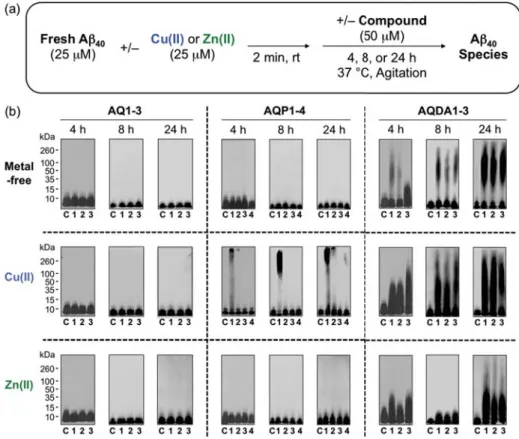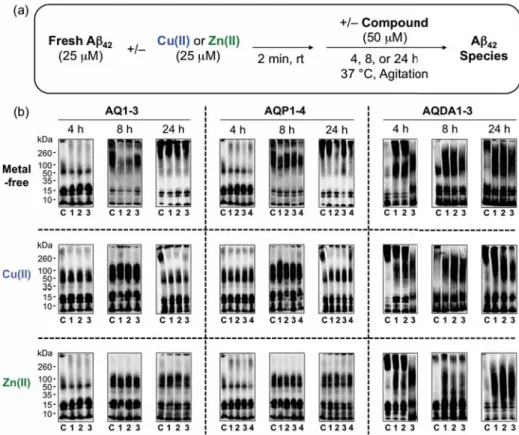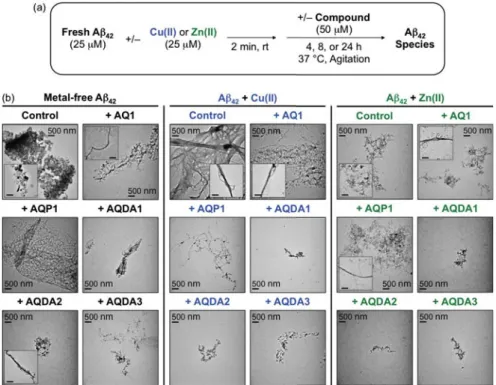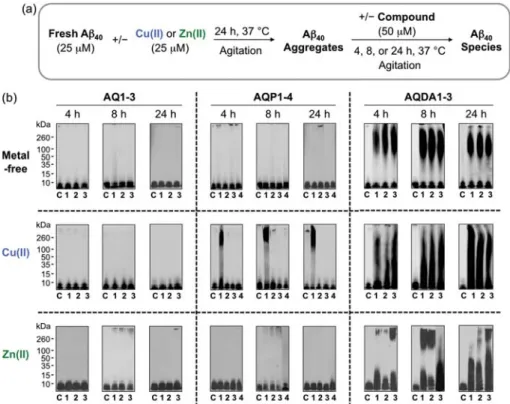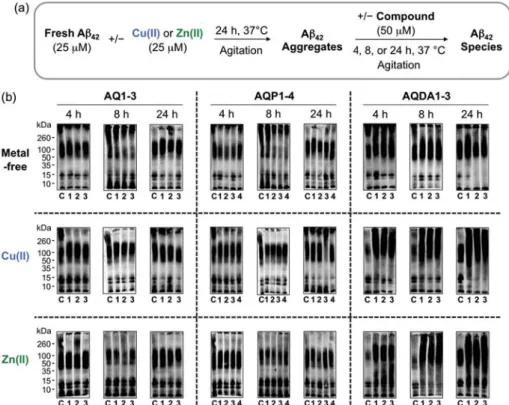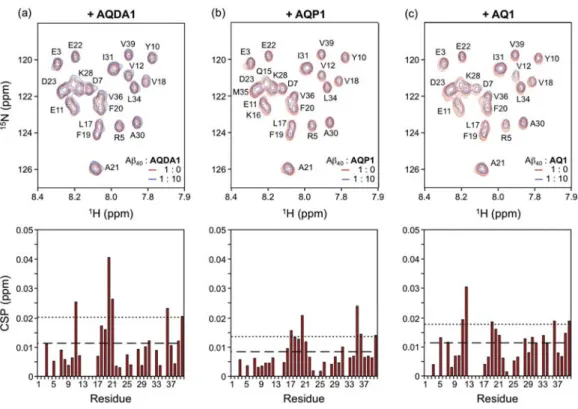Analysis of potential isomerization of trans-I-M(II)(TMC) complexes (M = Co, Ni and Cu) by UV-vis. Computational investigation of M(II)(TMC) complexes. e-f) Overlay of M(II)(TMC) ground state structures, viewed from the side and from above.
Introduction
Alzheimer’s Disease
Processing of amyloid precursor protein (APP) by β- and γ-secretases [green segment: respective soluble N-terminal cleavage products, sAPPα and sAPPβ; red segment: amyloidogenic isoforms, Aβ40 and Aβ42; blue segment: APP intracellular domain (AICD)] leads to the production of Aβ40 and Aβ42 monomers, which can go through a slow nucleation phase followed by a rapid elongation phase, resulting in the formation of mature aggregated fibrils. Dyshomeostasis and metal maldistribution in AD-affected brains have complemented the metal ion hypothesis, which attributes misregulated metals as a causative feature in the onset and progression of the disease.
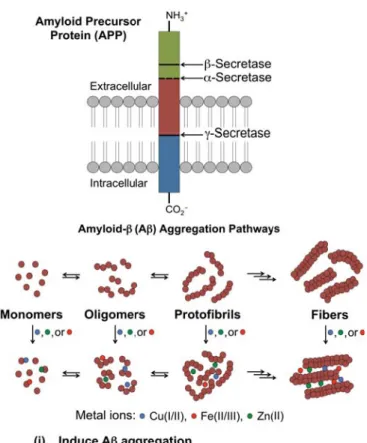
Anti-Amyloidogenic Compounds
Inhibition of β- and γ-secretases leads to a reduction in the amyloidogenic forms of Aβ, while stimulation of α-secretase increases the production of the shorter, non-amyloidogenic forms and sAPPα, the neuroprotective N-terminal cleavage product. A representation of the tetravalent foldamer-dendrimer conjugates developed to target low molecular weight (LMW) Aβ species (ie, oligomers, black sphere).
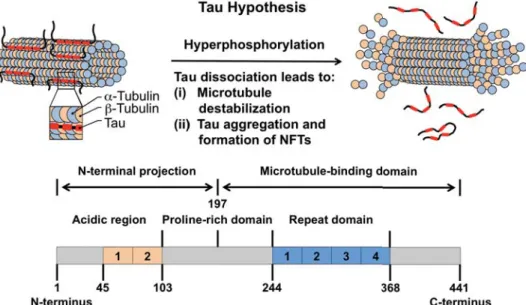
Metal Chelators and Ionophores
Instead, the characteristics of the peptide must be taken into consideration to optimize any of its characteristics and confer selectivity. Capitalizing the self-recognition sequence (KLVFF) of the central hydrophobic core of Aβ provides an example used by Wu and colleagues.55 They added the Aβ recognition sequence known to be important in the aggregation pathway and design of β- leaf-breaking compounds (vide supra) on an apo-cyclen framework (Scheme.
Multifunctionality
Furthermore, the simultaneous use of multiple compounds to treat different disease parameters also greatly increases the probability of generating adverse side effects.65. Recent recognition and growing acceptance of the multifactorial nature of AD and other neurodegenerative disorders has led to rapid growth in the development of these types of molecules, and as a result, full reviews can be devoted to this topic.
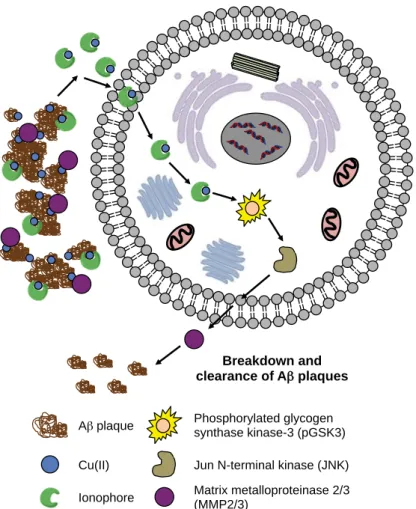
Tau-Related Strategies
The formation of MT stabilizing agents began with the use of paclitaxel, a natural product isolated from the bark of the western yew (Taxus brevifolia).89,91 Michaelis et al. Moreover, structure-reactivity studies have been limited to determining the main chemical properties of such compounds.
Conclusions
In general, MT-stabilizing molecules have been largely limited to the analysis and testing of natural products; however, very little progress has been made in the fabrication of synthetic analogs. Detailed structure-based screening, similar to those performed for transthyretin-stabilizing compounds, may guide the evolution of more potentially BBB-permeable scaffolds that may guide novel AD therapeutic discovery.94.
Importance of the Dimethylamino Functionality on a Multifunctional Framework for
Results and Discussion
- Design Rationale and Preparation for Structural Modifications to a Multifunctional
- Effect of AQ Derivatives on Metal-Free and Metal-Induced Aβ Aggregation
- Direct Interaction Between Soluble Metal-Free A β and AQ Derivatives
- Analysis of AQ Derivatives Incubated with A β 40 by Ion Mobility–Mass Spectrometry
- Metal Binding Properties of AQ Derivatives
It is also worth noting that the exact quantification of the selectivity for Cu(II) over Ni(II) and Zn(II) for AQP4 and Co(II) for AQDA1 could not be determined due to the optical overlap of their respective metal bonds band, but the overall spectral changes indicated preferential binding to Cu(II) (Figure 2.18). The TEAC values are relative to the vitamin E analogue Trolox (6-hydroxy-2,5,7,8-tetramethylchroman-2-carboxylic acid). 80% was measured for N2a cells treated with 5 μM of the AQ derivatives in the absence and presence of metal ions (CuCl2 or ZnCl2) (Figure 2.20a,b).

Conclusions
In particular, with the exception of ML, the multifunctional derivatives containing the 4-(dimethylamino)phenol functionality are indicated to be relatively more cytotoxic. Based on NMR studies, this dimethylamino moiety appears to act to control the distribution of the compounds' interaction with the N-terminal metal-binding region and/or the central self-recognition sequence of Aβ40. Substitution of the primary alcohol on ML with a hydrogen atom enabled the formation of 1:1 and 1:2 (metal:ligand) complexes, giving a higher binding affinity for Cu(II) compared to the other AQ derivatives.
Experimental Section
- Materials and Methods
- Synthesis
- Preparation of 2-(((2-Methylquinolin-8-yl)amino)methyl)phenol (AQP2)
- Preparation of Methyl 8-((2-hydroxybenzyl)amino)quinoline-2-carboxylate (AQP3)
- Preparation of 2-(((2-(Hydroxymethyl)quinolin-8-yl)amino)methyl)phenol (AQP4)
- Preparation of 4-(Dimethylamino)-2-((quinolin-8-ylamino)methyl)phenol (AQDA1)
- Preparation of 4-(Dimethylamino)-2-(((2-methylquinolin-8-yl)amino)methyl)phenol
- Preparation of Methyl 8-((5-(dimethylamino)-2-hydroxybenzyl)amino)quinoline-2-
- A β Aggregation Experiments
- Gel Electrophoresis with Western Blotting
- Transmission Electron Microscopy (TEM)
- Docking Studies
- Ion Mobility–Mass Spectrometry
- Metal Binding Experiments
- Solution Speciation Studies
- Trolox Equivalent Antioxidant Capacity (TEAC) Assay
- Parallel Artificial Membrane Permeability Adapted for the Blood-Brain Barrier (PAMPA-
- Cell Viability Measurements
Finally, the efficacy of our approach in biological environments [e.g., live cells, in vivo (i.e., the AD 5xFAD mouse model)29] was examined. Cu(II) fibrils (or monomers; vide infra) show no indication of photoreduction under identical experimental conditions, while studies of DMPD-incubated Cu(II) fibrils show no photochemistry after repeated EXAFS scans under the experimental conditions used. i.e. the Cu(II) has already been reduced to Cu(I) before X-ray exposure (Figure 3.7). All samples were measured with the addition of an internal standard of melittin (5 μM). e) The amount of remaining singly charged Aβ40 after treatment with M(II)(TMC) is estimated and summarized in the table.
To have an axial ligand, either H2O or OH–, the Ni center would have to convert to a triplet spin state. Schemes of the potential modes of action of M(II)(TMC) to modulate Aβ aggregation. a) The conformation of Aβ is altered leading to the generation of aggregates off the pathway by (i) coordination to the metal center of M(II)(TMC) [e.g. Aβ–M(II)(TMC)]; (ii) intermolecular coordination of Aβ to two equivalents of M(II)(TMC); (iii) isomerization to the trans-III stereoisomer and subsequent formation of an octahedral complex. Perhaps the most interesting property of TMC is the characteristic stereochemistry of its metal complexes which can theoretically be found in five possible diastereoisomeric forms with the two most thermodynamically stable being the trans-I and trans-III isomers (Figure A.1).2 The two isomers have many different fundamental properties (e.g., catalytic activity, kinetic stability, redox chemistry) of which the most obvious are their coordination environments. The trans-I metal complexes that have all four methyl units positioned almost on the same side of the macrocyclic plane. always generate tetracoordinate square planar complexes or pentacoordinate square pyramidal or trigonal bipyramidal (TBP) structures while the trans-III metal complexes tend to produce exclusively hexacoordinate octahedral complexes.2 Almost all metal TMC complexes, especially those with 3d metal centers, are formed in the trans-I structures where isomerization of the trans-I complex to the trans-III conformation has been shown to be difficult and highly dependent on solution conditions.2,26 As a result, very little is known about the properties and fundamental chemistry of the trans-III metal TMC complexes.2 Therefore, due to the importance and broad application of TMC and other N-methylated cyclam ligands, an easy and fundamental comprehensive approach to selectively and systematically prepare the trans-III.
630 nm which was consistent with previous literature reports of pentacoordinate trans-I-[Cu(TMC)]2+ complexes which would be expected following this synthetic procedure (i.e., direct metalation of TMC; Figure A .2, solid line) .3 Surprisingly, the peak in the optical spectrum of [Cu(TMC)](NO3)2 was more intense and.
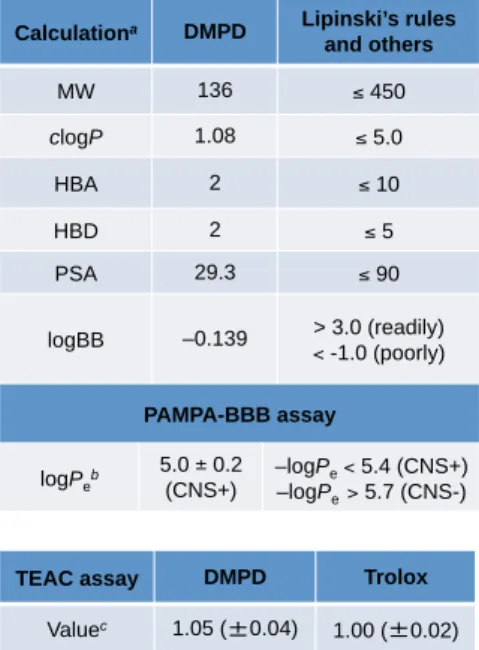
Acknowledgements
A redox-active, compact molecule for cross-linking amyloidogenic peptides into non-toxic, off-path aggregates: in vitro and in vivo. Younwoo Nam and Hyuck Jin Lee were involved in the gel/Western blot, UV-vis, and TEM experiments. I was instrumental in designing and performing experiments as well as writing the manuscript with the help of Professor Lim.
Introduction
To this end, we present a redox-active, compact amine derivative, DMPD (N,N-dimethyl-p-phenylenediamine; Figure 3.2a), as a new chemical tool for the redirection of both metal-free Aβ and metal–. Biophysical analyzes and molecular dynamics (MD) simulations indicate molecular level interactions of DMPD with both metal-free Aβ and metal-Aβ in vitro as well as its potential mechanism, based on the formation of intramolecular cross-links between transformed DMPD and Aβ, for redirecting the peptide aggregation . Taken together, our in vitro and in vivo studies of a redox-active small molecule, together with the molecular level mechanistic elucidation, illustrate that the strategy of generating Aβ–small molecule adducts can be an effective tactic to prevent the formation of relatively less toxic aggregates of down the road
Results and Discussion
- Rational Selection of DMPD Toward Redirecting Both Metal-free and Metal-induced A β
- Effects of DMPD on Both Metal-Free and Metal-Induced A β Aggregation In Vitro
- Proposed Mechanism of DMPD’s Control Against Aβ Aggregation Pathways
- Attenuation of Metal-Free A β -/Metal–A β -Induced Toxicity in Living Cells by DMPD
- In Vivo Efficacy of DMPD Against Amyloid Pathology and Cognitive Impairment
The interaction of DMPD with metal-free Aβ monomers was examined by 2D NMR spectroscopy and MD simulations (Figure 3.5a-c). The total exposure time for each scan is approx. iii) Transformation of DMPD in the absence and presence of Aββ and Metal ions. Cytotoxicity of DMPD in the absence and presence of metal ions and its effect toward metal-free/metal-treated Aβ40-induced cytotoxicity.
Conclusions
Using the Morris water maze task, spatial learning and memory activities were compared in wild-type 5×FAD mice and their littermates after thirty consecutive treatments with vehicle or DMPD (1 mg/kg/day, i.p.). a). The graphs below show the time spent in the target quadrant (NW, highlighted in grey). In the current study, a compact chemical tool, DMPD, is presented to redirect Aβ aggregation in the absence and presence of metal ions into non-toxic off-pathway aggregates using a novel approach (i.e., intramolecular cross-linking with aggregation-prone peptides and redox-active small molecule transformation). .
Experimental Section
- Materials and Methods
- A β Aggregation Experiments
- Gel Electrophoresis and Western Blot
- Transmission Electron Microscopy (TEM)
- Computational Procedure
- Cu K-edge X-ray Absorption Spectroscopy
- Mass Spectrometric Studies
- Animals and Drug Administration
- Tissue Preparation
- Aβ 40 /Aβ 42 Quantification
- Quantification of A β Plaques
- Behavioral Evaluation
- Statistics
- Trolox Equivalent Antioxidant Capacity (TEAC) Assay
- Parallel Ariticial Membrane Permeability Adapted for the Blood-Brain Barrier (PAMPA-
- Metabolic Stability Measurements
- Cell Viability Measurements
In the first step, 100 ns MD simulations were performed in aqueous solution to obtain the equilibrated structure of the Aβ40 monomer. The UV-vis spectra of the solutions in the reference, acceptor and donor plates were measured with a microplate reader. Immediately, an aliquot of the resulting solution (150 μL) was mixed thoroughly with acetonitrile (CH3CN; 150 μL) in a plastic HPLC vial and then sealed.
Acknowledgements
The line of best fit was calculated using the first-order kinetic equation {[A]t = [A]o x e-kt, where [A]o is the initial concentration of DMPD; t is time; k is the speed (dependent variable)}. Using a plot of the inverse of substrate concentration versus the inverse of velocity, the values of Vmax (maximum velocity) and KM (binding constant) were calculated using the Lineweaver-Burk equation. Formazan produced by the cells was dissolved in a solution containing N,N-dimethylformamide (DMF, 50% v/v aq, pH 4.5) and sodium dodecyl sulfate (SDS, 20% w/v) overnight at room temperature.
Cu K-edge studies were previously performed at beamline X3-b supported by the Case Center for Synchrotron Biosciences, funded through the National Institute of Biomedical Imaging and Bioengineering (NIH P30-EB-009998). I thank Prof. Jaeheung Cho and Hyeonwoo Tak for their assistance in synthesis and X-ray crystallography, Prof. Kiyoung Park and Jiwan Lee for DFT calculations, Dr. I was also instrumental in designing the experiment and proposing a general mechanistic understanding as writing the manuscript with the help of Professor Lim.
Introduction
TMC was chosen because of its special properties (e.g., stereochemistry, coordination number) and its ability to adapt to different oxidation and spin states of the metal centers, which we predicted would mediate different reactivities of M(II)(TMC) than those of analogous cyclic complexes and because of the simplicity with which they can be synthesized and structurally modified. The anti-amyloidogenic activity of Co(II)(TMC) is thought to be due to its enhanced ability to hydrolyze Aβ compared to other complexes. Ultimately, the mechanistic insights illuminated in our studies will be combined with the dependence on the metal center to guide the rational design of a next-generation array of tunable cleavage agents.
Results and Discussion
- Design Rationale and Preparation of M(II)(TMC) Complexes
- Effects of M(II)(TMC) on Aβ Aggregation
- Mechanistic Studies
- Computational Mechanistic Insights
- Proposed Mechanisms for the Hydrolysis of A β by Co(II)(TMC)
- Biological Applicability of M(II)(TMC) Complexes
As shown in Figure 4.1, both Co(II)(TMC) and Ni(II)(TMC) complexes were in the expected trans-I conformation. To validate the size of the hyperfine bond of 17O bound to the Co(II) center, 17O ESEEM experiments were performed on CoCl2 prepared in 17O-labeled water (70% enrichment) (Figure 4.14). Then, the MTT assay [MTT = 3-(4,5-dimethyl-2-thiazolyl)-2,5-diphenyl-2H-tetrazolium bromide] was used to evaluate the cytotoxicity of Co(II) (TMC) using human SH-SY5Y (5Y) neuroblastoma cells (Figure 4.18).
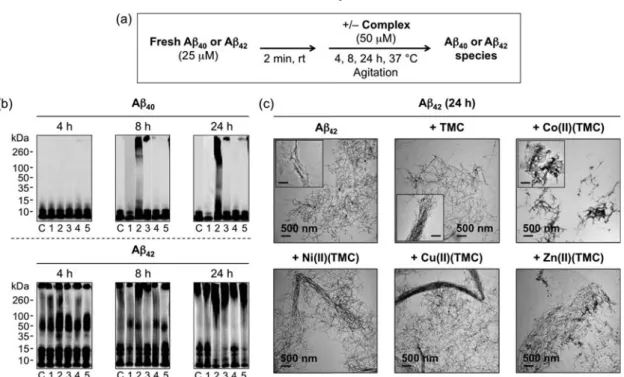
Conclusions
All measurements were performed with the addition of an internal standard, melittin (5 μM) and calibrated based on the linear correlation between concentration and signal intensity. Overall, our mechanistic studies suggest that in addition to tuning the cleavage reactivity of metal complexes through the choice of metal ions, we can also further enhance hydrolytic cleavage by promoting a concerted reaction mechanism by providing two or more open coordination citations. cis to the metal center to facilitate amide bond activation and simultaneous production and attack by a hydroxo ligand via an intramolecular manner. Taken together, our findings on the dependence of the metal center for cleavage of amyloidogenic peptides, together with mechanistic insights, not only provide a new strategy by which the cleavage activity and selectivity of proteolytic metal complexes can be tuned, but also shows that high potency, which often leads to poor substrate selectivity, is not required to achieve the desired anti-amyloidogenic reactivity.
Experimental Section
- Materials and Methods
- Preparation of M(II)(TMC) Complexes
- A β Aggregation Experiments
- Gel Electrophoresis with Western Blotting
- Transmission Electron Microscopy (TEM)
- Electron Paramagnetic Resonance Spectroscopy (EPR)
- Matrix-Assisted Laser Desorption Ionization Mass Spectrometry (MALDI–MS)
- Computational Details
- Competition Experiments
- Internal Standard Calibration
- Electrospray Ionization–Mass Spectrometry (ESI–MS)
- Isomerization Experiments
- Parallel Artificial Membrane Permeability Adapted for the Blood-Brain Barrier (PAMPA-
- Cell Viability Measurements
All pulsed ENDOR spectra were obtained using stochastic sampling for a better baseline of the spectra. The concentration of the solution was determined by measuring the absorbance of the solution at 280 nm (ε = 1450 M-1cm-1). The calibration equation was derived from the linear regression of the signal intensity ratio values.
Acknowledgements
UV-vis spectra of the solutions in the blank, reference, acceptor and donor plates were measured using a microplate reader. Cell viability after treatment of Co(II)(TMC) was determined by the MTT assay [MTT = 3-(4,5-dimethyl-2-thiazole)-2,5-diphenyl-2H-tetrazolium bromide, Sigma-Aldrich] . Formazan produced by the cells was solubilized by adding an acidic solution of N,N-dimethylformamide (DMF, 50% v/v, aq, pH 4.5) and sodium dodecyl sulfate (SDS, 20% w/v) overnight at room temperature in the dark.
The trans-III isomer generates octahedral complexes by binding two ligands at the open axial sites. This degree of deformation was not observed in the trans-III-[Cu(TMC)](NO3)2 complex whose metal center lies in the same plane as the four N-donor atoms of the macrocycle. Overall, our initial spectroscopic findings with [Cu(TMC)]2+ support the fact that the facile initiation of trans-III metal-TMC complexes can be accomplished by the careful selection of the metal salt.
![Figure A.1. Chemical structures of [M(TMC)] 2+ (TMC = 1,4,8,11-tetramethyl-1,4,8,11- 1,4,8,11-tetramethyl-1,4,8,11-tetraazacyclotetradecane)](https://thumb-ap.123doks.com/thumbv2/123dokinfo/10534528.0/190.892.304.611.513.601/figure-chemical-structures-tmc-tmc-tetramethyl-tetramethyl-tetraazacyclotetradecane.webp)
